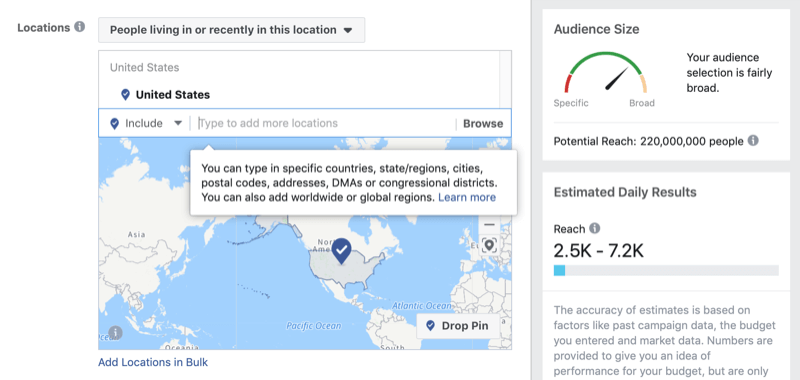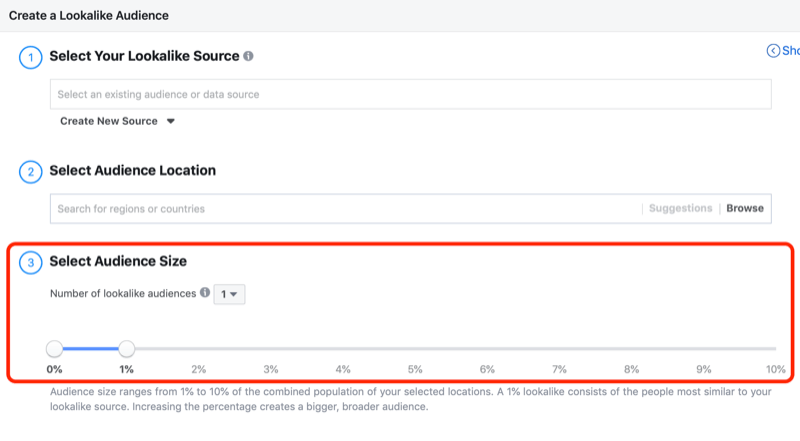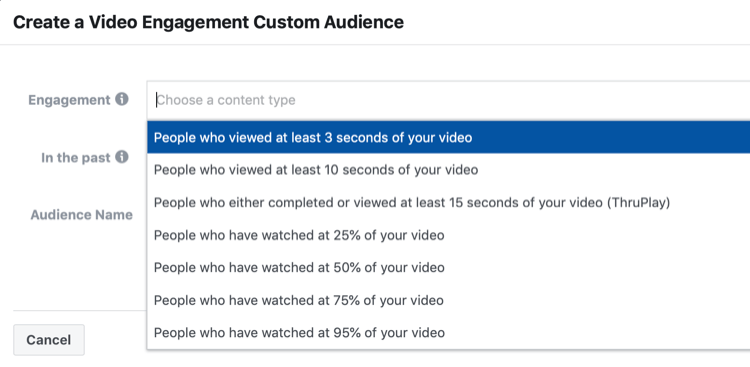Want to maximize the results of your top-performing Facebook ads? Looking for ways to get more leads or sales from your existing Facebook ad campaigns?
In this article, you’ll discover four horizontal and vertical ad-scaling techniques for Facebook ads.


Horizontal Facebook Ad Scaling
To scale your Facebook ads for reach, try adding new ad sets to your campaign as you increase your ad budget. This process is known as horizontal scaling, and it involves researching new audiences using Facebook Audience Insights. Alternatively, you could create Facebook lookalike audiences, which expand on your existing lookalikes; for example, a 5% lookalike vs. a 1% lookalike.
With horizontal scaling, you spread testing across multiple ad sets, audiences, and ad creative. All of the following horizontal scaling strategies can be effective ways of growing and scaling your Facebook campaigns.
#1: Increase the Geographic Area of Your Audience Targeting
The type of business you run may determine the size of the audience you’re targeting with your Facebook ads. If your customers are located in a particular area, for instance, you may start by targeting your ads to that spot.
But if you’re looking for a way to scale your Facebook campaigns, consider increasing the geographic area you’re targeting.


Whether you can do this may depend on the product you’re selling and the distribution system you have in place to fulfill orders. However, if you identify other markets and regions to sell to and see traction from these campaigns, you’re well on your way to attracting new customers. If the products you’re selling can be shipped internationally, it’s worth testing your ads in new locations.
Once your Facebook pixel has collected enough data about what your ideal customer looks like in one country, you can apply these lessons to target markets in other countries. To visualize this, if your initial campaign targets customers in the U.S. and those campaigns are seeing success, there’s a good chance the same campaigns may work in other countries as well.
When you change the target location of your ad campaigns, you may need to make a few tweaks to your ads, especially if they refer to a specific place. Keep your ad spend small when you’re targeting a new location with your ads.
#2: Increase the Size of a Facebook Lookalike Audience
A Facebook lookalike audience will likely be filled with prospects who are similar to your best existing customers. When you build a lookalike, you choose a source audience, which is a custom audience built using data from your Facebook pixel. Facebook then identifies the common qualities of the people in your source audience and lets you deliver an ad to people who are like them.
You can choose the size of your lookalike audience—the smaller the audience, the closer it will match your source audience. While a higher-percentage lookalike can increase your potential reach, the audience will be less similar to your source audience.


If you want to scale a lookalike audience by increasing the audience size percentage, it’s worth starting off with a small audience and seeing how receptive they are to your ads. If your ads perform well with a small lookalike, slowly scale your lookalike to see if a larger audience is receptive.
Successfully scaling a lookalike audience will get more eyes on your product or brand and can be an effective way of scaling your Facebook campaigns.
#3: Change Your Facebook Ad Creative and Segment Your Audience
How your audience reacts to your Facebook ads will depend on where people are in the customer journey. This is why it’s important to carefully consider your objectives for each campaign.
For instance, if your objective is to inform cold prospects about your product, a video ad like the one below that explains what your product is and does could be a useful way to grow awareness of your brand or product. When you’re creating new content for your ads, always keep your campaign objectives in mind.
Once you’ve run the video ad, you’ll be able to track the data and metrics. You can see not only how many people watched the video but also what percentage of the video they watched. If your video is a success, you’ll move cold prospects to the next stage of your funnel, where you can focus on nurturing them as prospective customers.
After you run an ad campaign and get insights into the behaviors of your customers and prospects, segment your warm audience. To illustrate, for a video ad, you segment by how much people watched—25%, 50%, 75%, and 100% of your video.


You may also want to look at how many people visited your website as a result of your ad campaign via the Facebook pixel and then design ad creative specifically targeting those visitors. Whatever metrics or data points you look at, segmenting your audience will give you an idea of where best to focus your ad efforts.
As you begin to scale your ads and attract leads, your pool of warm prospects will undoubtedly grow. Now you can really focus on moving potential customers down your sales funnel.
For an eCommerce store, you might have insights into how many people abandoned their cart on your site in the last 30, 60, or 90 days. You know that potential customers who have abandoned their cart are close to making a purchase, so retargeting this group may help you convert some of these would-be buyers into paying customers.
If you have a lot of prospects visiting your site but not converting to buyers, that may indicate that something is wrong with your offer or your website. The more insights you can get into what is and isn’t working with your campaign, the better equipped you’ll be to create more successful marketing campaigns in the future.
Vertical Facebook Ad Scaling
#4: Increase Your Budget
Increasing your ad spend every 3–5 days is advisable early on, particularly if you’re beginning to see good returns from a set of ads. This type of scaling is known as vertical scaling.
A sustainable way to see if your ad spend is giving you the results you need is to keep a close eye on your return on ad spend (ROAS). If you’re spending $50 per day on ads and those ads are leading to $300 in sales per day, you have a ROAS of 6.0 so you know your ads are working.
If you see these results, you may think that if you keep increasing your ad spend, your profits will continue to grow. This is where some caution may be necessary. Often, when you start increasing your ad spend, your ROAS ends up staying the same.
Continuing the previous example, suppose you raise your daily ad spend to $100 per day and you still see sales of $300. Your ROAS has dropped to 3.0, which may indicate that your set of ads is reaching its maximum potential.
Of course, if you still see a profit or a positive ROAS, you may want to keep that particular ad set running. It’s important to keep an eye on your campaign to make sure your ads remain effective and so you can implement small changes if needed.
Conclusion
Brands and businesses of all sizes rely on Facebook ads to reach new customers, nurture prospects, build brand awareness, and ultimately grow. If you can get your ad campaigns right, you’ll have unlocked a powerful method to grow your business.
Before you start any Facebook campaign, decide what kind of customer you want to attract, what their demographics are, and what you want to achieve such as getting more leads or increasing sales. Whatever your marketing and advertising goals, there are plenty of strategies you can implement to scale your Facebook campaigns successfully.
When scaling your campaigns, take a deep dive into the analytics of each campaign you’ve launched so you know what’s working and what’s not. And as mentioned throughout this article, if you decide to scale the budget for your campaigns, do so in slow increments. This will give you the time and opportunity to test strategies without overspending.

Thank you, your site is very useful!
Pingback: Grow Your Agency with White Label PPC Facebook Ads! : Ankita Mankotia